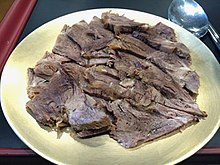
Summary
Pyeonyuk (Korean: 편육; Hanja: 片肉) is a traditional Korean dish, which consists of thinly sliced meat that has been boiled and pressed.[2] Either beef or pork may be used to make the dish.
 Beef pyeonyuk | |
| Place of origin | Korea |
|---|---|
| Associated cuisine | Korean cuisine |
| Serving temperature | 15–25 °C (59–77 °F) |
| Main ingredients | Beef (brisket, plate, foreshank, tongue, testicle, mammary, head, liver, spleen, trotters) or pork (belly, head, trotters) |
| 42.5 kcal (178 kJ)[1] | |
| |
| Korean name | |
| Hangul | 편육 |
|---|---|
| Hanja | 片肉 |
| Revised Romanization | pyeonyuk |
| McCune–Reischauer | p'yŏnyuk |
| IPA | [pʰjʌ.njuk̚] |
It is eaten as anju (an accompaniment to alcoholic drinks), or used as a topping for other dishes such as naengmyeon (cold noodles) and seolleongtang (ox bone soup).[3] In the past, pyeonyuk was made during the preparation of a large amount of beef stock or broth for various dishes served during feasts and banquets.[4] Today, it is also used in non-traditional dishes, such as a cold cut in wrap sandwiches, and is considered to be a healthier alternative to deep-fried, stir-fried, or roasted meat.[3]
Preparation and serving edit
Beef pyeonyuk mainly uses brisket, plate, foreshank, tongue, testicle, mammary, head, liver, spleen, and trotters, while pork pyeonyuk uses belly, head, and trotters.[5]
The meat is always soaked in cold water to remove blood, and it is boiled as a whole chunk until tender.[6] The broth for cooking the meat is flavored with salt and other seasonings that may vary from household to household, and can include doenjang (soybean paste), soju, cheongju (rice wine), black peppercorns, or coffee powder.[3] Scallions and whole garlic cloves are a common addition in the broth when beef is used, and sliced ginger for pork.[6]
After the meat is tender, it is wrapped in cloth and pressed with a weight.[6] Then it is sliced thin and served with a dipping sauce: cho-ganjang (soy sauce–vinegar mixture) or gyeoja-chojang (soy sauce, vinegar, and mustard mixture) for the beef pyeonyuk, and saeu-jeot (salted shrimps) for the pork pyeonyuk.[5] Pork pyeonyuk may also be eaten wrapped with baechu-kimchi (cabbage kimchi), or in lettuce or perilla leaves as ssam (wrap).[2][5] Common side dishes for pyeonyuk include geotjeori (fresh kimchi), mu-mallaengi-muchim (spicy dried radish salad), and saengchae-muchim (spicy vegetable salad).[3]
Pyeonyuk may also be used as a topping for other dishes such as naengmyeon (cold noodles), and seolleongtang (ox bone soup).[3]
Gallery edit
-
Suyuk (boiled pork slices) and pyeonyuk (pressed boiled beef slices)
-
Dwaeji-meori-pyeonyuk (pressed boiled pork head slices) served with garlic
-
See also edit
References edit
- ^ "Yangji-meori-pyeonyuk" 양지머리편육. Korean Food Foundation (in Korean). Retrieved 5 July 2017.
- ^ a b "Main meals/Side dishes". Food in Korea. Korea Agro-Fisheries Trade Corporation. Archived from the original on 14 April 2009. Retrieved 17 May 2008.
- ^ a b c d e Lee, Jon-im (Spring 2011). Lee, Kyong-hee (ed.). "Pyeonyuk: Sliced Beef". Koreana. Vol. 24, no. 1. pp. 76–79. Retrieved 5 April 2013 – via issuu.
- ^ 주, 영하 (5 July 2011). "[주영하의 음식 100년](18) 편육". Kyunghyang Shinmun (in Korean). Retrieved 5 July 2011.
- ^ a b c 이, 효지. "Pyeonyuk" 편육. Encyclopedia of Korean Culture (in Korean). Academy of Korean Studies. Retrieved 6 July 2017.
- ^ a b c "Pyeonyuk" 편육. Doopedia (in Korean). Doosan Corporation. Retrieved 6 July 2017.


